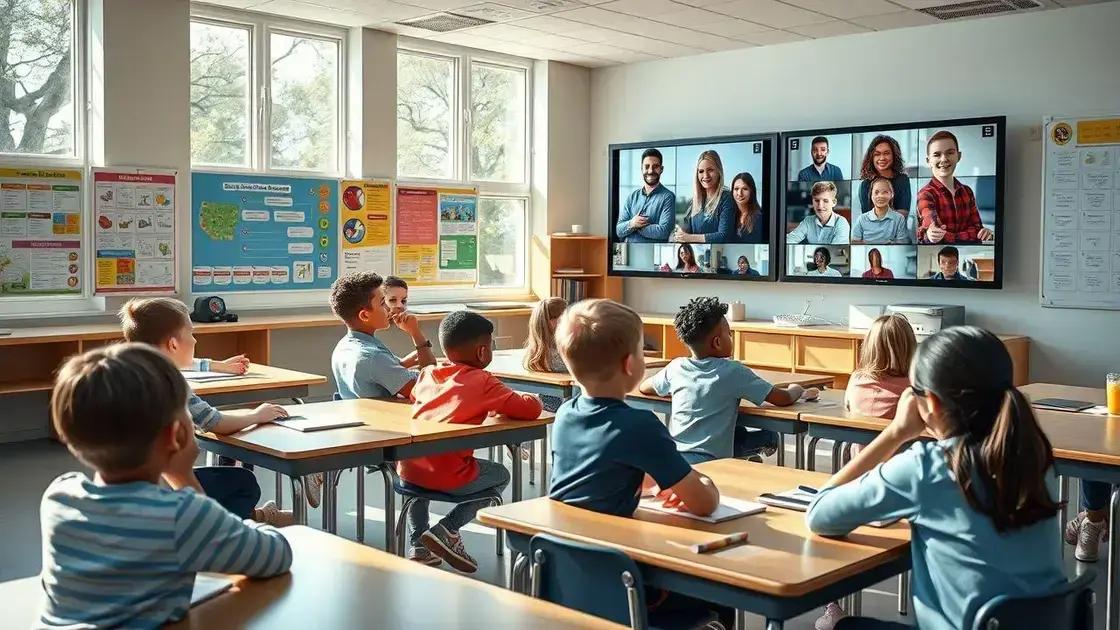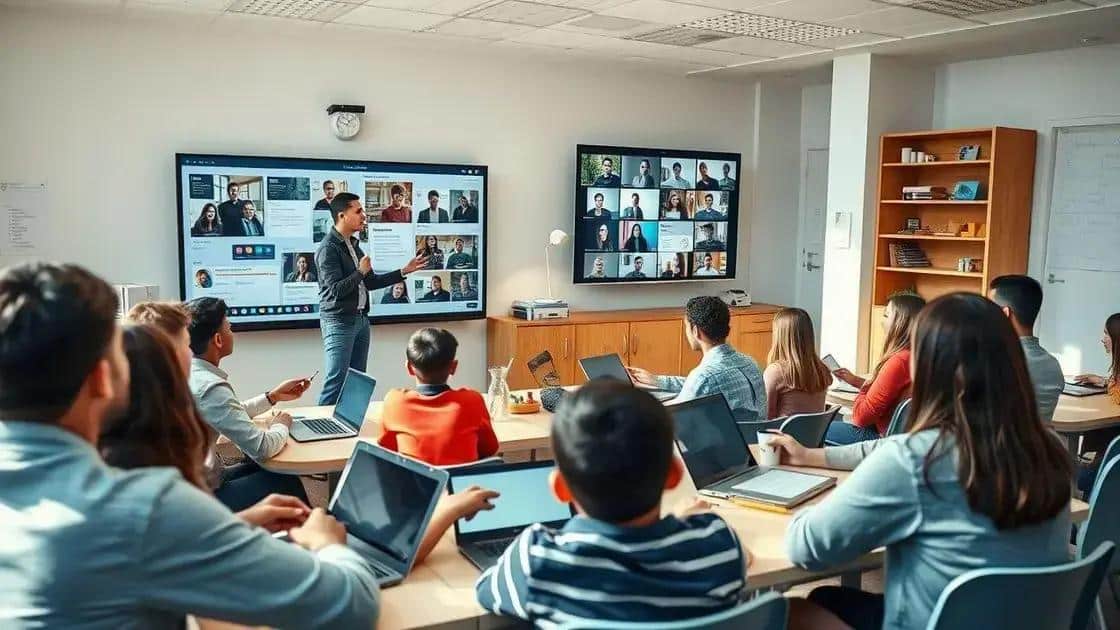Latest on hybrid learning success: Strategies that work

Hybrid learning combines in-person and online education, offering flexibility and accessibility while enhancing student engagement through diverse teaching methods and effective communication strategies.
Latest on hybrid learning success is transforming education as we know it. Have you noticed how blended methods enhance student engagement? Let’s explore what truly works in this evolving landscape.
Understanding hybrid learning
Understanding hybrid learning is essential for adapting to modern educational needs. This blend of in-person and online instruction can engage students effectively. It offers flexibility while maintaining valuable face-to-face interactions.
What is hybrid learning?
Hybrid learning combines traditional classroom teaching with online resources. This method allows students to learn at their own pace while still receiving guidance from teachers. It can enhance learning by catering to different learning styles.
Benefits of hybrid learning
- Flexibility: Students can choose when and how they learn.
- Accessibility: Resources are available online, making it easier for students to access materials.
- Engagement: Interactive tools can create a more dynamic learning experience.
- Diverse resources: Teachers can use various formats to deliver content.
With hybrid learning, teachers have the chance to mix different teaching methods. This flexibility is vital, especially for students with varying needs. Many educators have found that using technology in learning creates more interest among learners.
Moreover, hybrid learning supports collaboration. Students can work together on projects, both online and in person. This interaction helps them build teamwork skills, even in a digital space. The integration of online discussions alongside regular classes can enhance peer communication.
Ultimately, the success of hybrid learning relies on how well it is implemented. Educators must consider their students’ preferences and needs when designing courses. Providing support and resources is crucial for a fruitful learning experience. Striking the right balance between online and in-person components can lead to improved outcomes.
Key benefits of hybrid learning environments

Key benefits of hybrid learning environments lie in their ability to combine the best aspects of traditional and online education. By offering flexibility, hybrid learning caters to a variety of learning styles and needs.
Improved accessibility
Hybrid learning allows students to access materials from anywhere, making education more inclusive. This means that students can engage with content on their own schedule, which is particularly useful for those balancing studies with work or family commitments.
Enhanced engagement
- Interactive tools: Online platforms often feature interactive elements that keep students engaged.
- Variety of formats: Learning through video, quizzes, and discussion boards helps to maintain interest.
- Personalized learning: Students can progress at their own pace, focusing on areas where they need more time.
- Immediate feedback: Online assessments provide quick insights into students’ understanding.
The blend of in-person and digital experiences also fosters collaboration and communication. Students can work together on projects from different locations, developing important skills for today’s workforce. They learn to collaborate using technology, preparing them for future careers.
Teachers, too, benefit from hybrid learning environments. They can track student progress through data analytics and adjust their teaching methods accordingly. This data-driven approach ensures that they can provide targeted support to students who may be struggling.
Furthermore, hybrid learning encourages a growth mindset. Students are often challenged to take responsibility for their learning. This empowerment fosters resilience and adaptability, essential traits in both academics and life. When faced with challenges, they learn how to seek help and utilize available resources proactively.
Challenges faced in hybrid learning
Challenges faced in hybrid learning can affect both students and educators. Understanding these issues is crucial for improving the learning experience.
Technology access
One significant challenge is the unequal access to technology. Not every student has reliable internet or devices at home. This digital divide can create barriers, preventing some students from fully participating in hybrid learning.
Engagement levels
- Distractions: Studying at home can lead to many distractions, making it hard to focus.
- Social interaction: Limited face-to-face interactions can reduce motivation and connection with peers.
- Online fatigue: Students may feel tired of virtual learning environments, impacting their desire to engage.
- Support systems: Some learners lack the necessary support at home for their educational needs.
Moreover, teachers face their own set of challenges while adapting to hybrid learning. Managing both in-person and online classrooms simultaneously requires strong organizational skills. It can be difficult to provide equal attention to all students, especially when they are learning in different environments.
In addition, maintaining a consistent curriculum across both platforms may result in discrepancies in content delivery. Teachers need to ensure that students receive the same quality of education, regardless of their method of learning. This often means extra preparation and training for educators to become proficient with digital tools.
Lastly, assessing student performance in a hybrid environment can be complicated. Traditional testing methods may not accurately reflect a student’s understanding when they have varying access to resources and support. Developing new assessment strategies that cater to both online and in-person students is essential for fair evaluation.
Best practices for educators in hybrid settings

Best practices for educators in hybrid settings include strategies that maximize student engagement and learning outcomes. By blending traditional teaching methods with technology, educators can create a productive environment for all learners.
Establish clear communication
Effective communication is crucial in a hybrid learning environment. Teachers should use various platforms, such as emails, discussion boards, or messaging apps, to keep students informed. This ensures that every student is aware of assignments, deadlines, and resources.
Use diverse teaching methods
- Incorporate multimedia: Use videos, podcasts, and infographics to present information.
- Encourage group work: Foster collaboration between online and in-person students.
- Provide hands-on activities: Include real-world tasks that can be performed both online and offline.
- Adapt to learning styles: Recognize and address the different ways that students learn.
Additionally, it is vital for educators to regularly check in with their students. They can schedule routine one-on-one meetings or small group discussions to gauge understanding and address concerns. This personalized attention helps nurture relationships, which is essential for motivation.
Furthermore, staying organized is key for success. Teachers should maintain a clear and concise schedule outlining important dates and expectations for both online and in-person components of the course. A well-structured curriculum allows students to plan their time effectively.
Lastly, providing feedback plays an essential role in the learning process. Educators can use various tools to deliver constructive feedback on assignments and assessments. This feedback should be timely and specific, guiding students on how to improve and progress in their learning journey.
In summary, navigating the hybrid learning landscape involves understanding its benefits and challenges. By implementing best practices, educators can create engaging and effective learning experiences. Communication, diverse teaching methods, and regular feedback are crucial for student success. As technology continues to evolve, adapting to these changes will help both teachers and students thrive in a hybrid environment. Embracing this approach can lead to a more inclusive and dynamic educational experience for everyone.
FAQ – Frequently Asked Questions about Hybrid Learning
What are the main benefits of hybrid learning?
Hybrid learning offers flexibility, improved accessibility, and enhanced engagement by combining online and in-person instruction.
What challenges do educators face in hybrid settings?
Challenges include technology access issues, maintaining student engagement, and managing disparate learning environments.
How can educators effectively communicate with students?
Educators should use various platforms, such as emails and messaging apps, to keep students informed of assignments and updates.
What are some best practices for teaching in hybrid environments?
Best practices include establishing clear communication, using diverse teaching methods, providing regular feedback, and staying organized.





